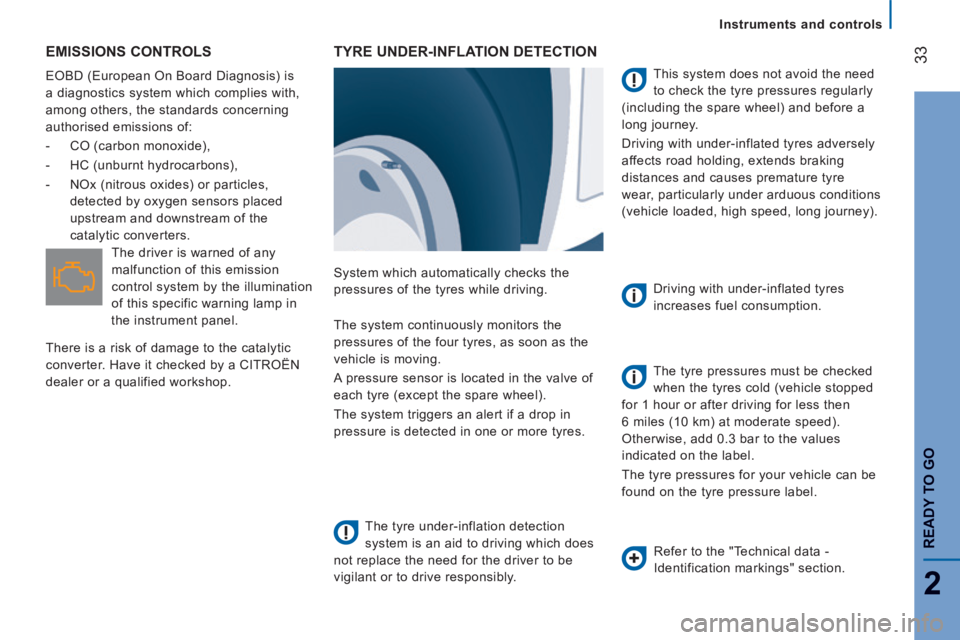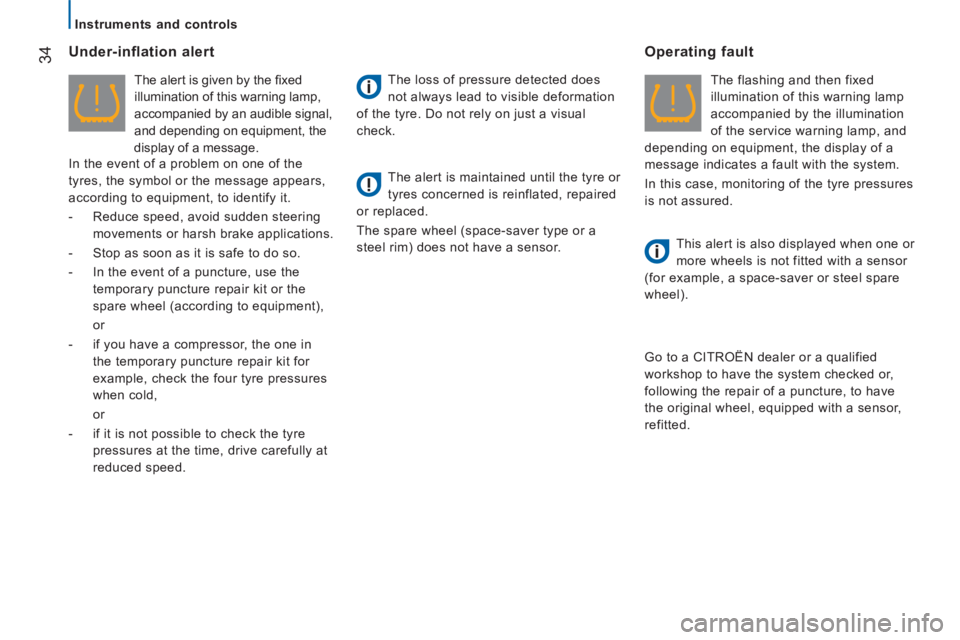inflation pressure CITROEN RELAY 2015 Handbook (in English)
[x] Cancel search | Manufacturer: CITROEN, Model Year: 2015, Model line: RELAY, Model: CITROEN RELAY 2015Pages: 248, PDF Size: 8.86 MB
Page 35 of 248

33
2
READY TO GO
Instruments and controls
EMISSIONS CONTROLS
EOBD (European On Board Diagnosis) is
a diagnostics system which complies with,
among others, the standards concerning
authorised emissions of:
- CO (carbon monoxide),
- HC (unburnt hydrocarbons),
- NOx (nitrous oxides) or particles, detected by oxygen sensors placed
upstream and downstream of the
catalytic converters.
TYRE UNDER-INFLATION DETECTION
System which automatically checks the
pressures of the tyres while driving.
The tyre under-inflation detection
system is an aid to driving which does
not replace the need for the driver to be
vigilant or to drive responsibly. This system does not avoid the need
to check the tyre pressures regularly
(including the spare wheel) and before a
long journey.
Driving with under-inflated tyres adversely
affects road holding, extends braking
distances and causes premature tyre
wear, particularly under arduous conditions
(vehicle loaded, high speed, long journey).
Driving with under-inflated tyres
increases fuel consumption.
The system continuously monitors the
pressures of the four tyres, as soon as the
vehicle is moving.
A pressure sensor is located in the valve of
each tyre (except the spare wheel).
The system triggers an alert if a drop in
pressure is detected in one or more tyres. The tyre pressures must be checked
when the tyres cold (vehicle stopped
for 1 hour or after driving for less then
6 miles (10 km) at moderate speed).
Otherwise, add 0.3 bar to the values
indicated on the label.
The tyre pressures for your vehicle can be
found on the tyre pressure label.
The driver is warned of any
malfunction of this emission
control system by the illumination
of this specific warning lamp in
the instrument panel.
There is a risk of damage to the catalytic
converter. Have it checked by a CITROËN
dealer or a qualified workshop.
Refer to the "Technical data -
Identification markings" section.
Page 36 of 248

34
Instruments and controls
Under-inflation alert
The alert is given by the fi xed
illumination of this warning lamp,
accompanied by an audible signal,
and depending on equipment, the
display of a message.
In the event of a problem on one of the
tyres, the symbol or the message appears,
according to equipment, to identify it.
- Reduce speed, avoid sudden steering
movements or harsh brake applications.
- Stop as soon as it is safe to do so.
- In the event of a puncture, use the temporary puncture repair kit or the
spare wheel (according to equipment),
or
- if you have a compressor, the one in the temporary puncture repair kit for
example, check the four tyre pressures
when cold,
or
- if it is not possible to check the tyre pressures at the time, drive carefully at
reduced speed. The loss of pressure detected does
not always lead to visible deformation
of the tyre. Do not rely on just a visual
check.
The alert is maintained until the tyre or
tyres concerned is reinflated, repaired
or replaced.
The spare wheel (space-saver type or a
steel rim) does not have a sensor.
Operating fault
The flashing and then fixed
illumination of this warning lamp
accompanied by the illumination
of the service warning lamp, and
depending on equipment, the display of a
message indicates a fault with the system.
In this case, monitoring of the tyre pressures
is not assured.
This alert is also displayed when one or
more wheels is not fitted with a sensor
(for example, a space-saver or steel spare
wheel).
Go to a CITROËN dealer or a qualified
workshop to have the system checked or,
following the repair of a puncture, to have
the original wheel, equipped with a sensor,
refitted.
Page 150 of 248

148
Puncture
PUNCTURE REPAIR KIT Repairing the tyre
- Apply the parking brake. Unscrew the tyre valve cap, remove the filling hose B
and screw the ring E onto the valve, - start the engine,
- insert the connector G
into the nearest
power socket on the vehicle,
- switch on the compressor by placing the switch F in position I (on),
- inflate the tyre to a pressure of 4 bars.
To obtain a more accurate reading, you are
advised to check the pressure value on the
pressure gauge H , with the compressor off.
- check that the switch F on the
compressor is in position 0 (off),
This temporary puncture repair kit is located
at the front of the passenger compartment.
It consists of:
- a cartridge A
, containing the sealant
fluid, equipped with:
● a filling hose B ,
● a sticker C indicating "max. 80 km/h",
which the driver must affix in full view
(on the dashboard) after repairing
the tyre,
- a quick guide to use of the repair kit,
- a compressor D equipped with a
pressure gauge and unions,
- adaptors, for the inflation of various items.